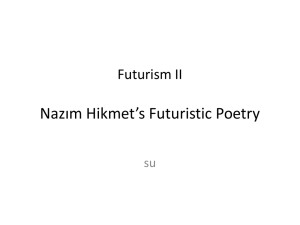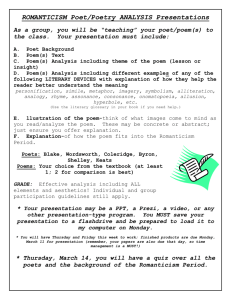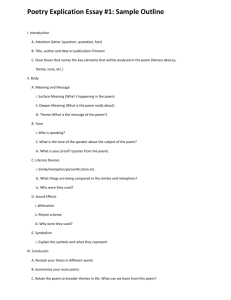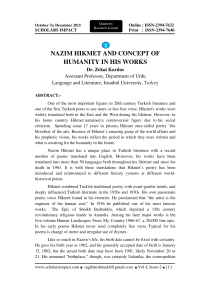Nazin Hikmet Summary
advertisement
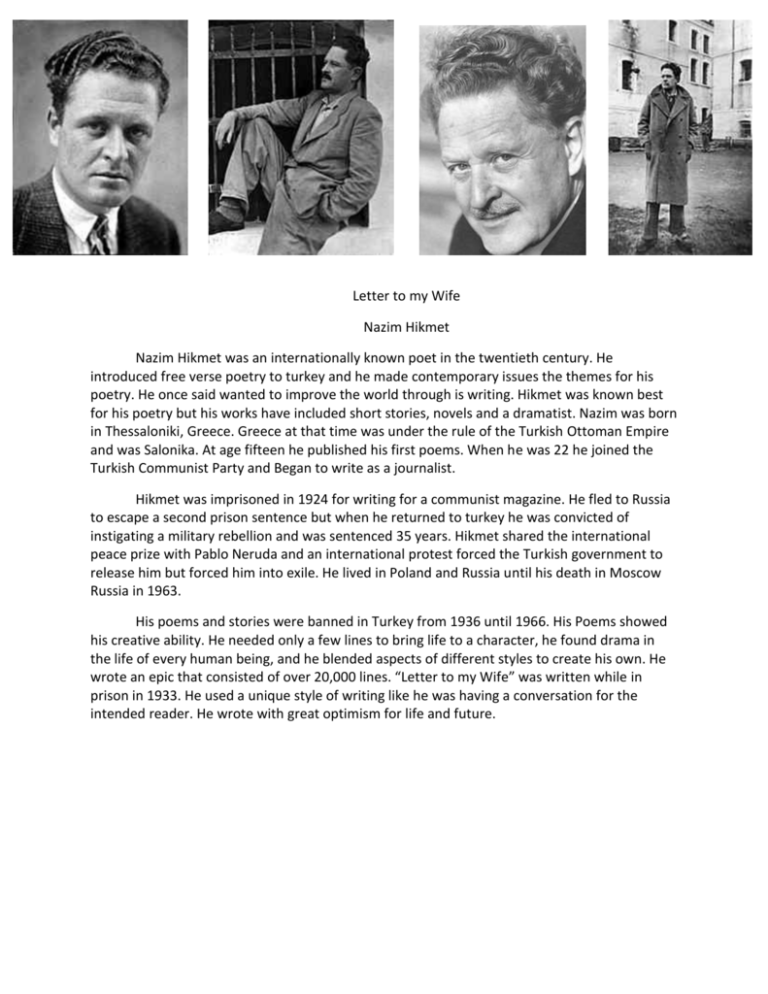
Letter to my Wife Nazim Hikmet Nazim Hikmet was an internationally known poet in the twentieth century. He introduced free verse poetry to turkey and he made contemporary issues the themes for his poetry. He once said wanted to improve the world through is writing. Hikmet was known best for his poetry but his works have included short stories, novels and a dramatist. Nazim was born in Thessaloniki, Greece. Greece at that time was under the rule of the Turkish Ottoman Empire and was Salonika. At age fifteen he published his first poems. When he was 22 he joined the Turkish Communist Party and Began to write as a journalist. Hikmet was imprisoned in 1924 for writing for a communist magazine. He fled to Russia to escape a second prison sentence but when he returned to turkey he was convicted of instigating a military rebellion and was sentenced 35 years. Hikmet shared the international peace prize with Pablo Neruda and an international protest forced the Turkish government to release him but forced him into exile. He lived in Poland and Russia until his death in Moscow Russia in 1963. His poems and stories were banned in Turkey from 1936 until 1966. His Poems showed his creative ability. He needed only a few lines to bring life to a character, he found drama in the life of every human being, and he blended aspects of different styles to create his own. He wrote an epic that consisted of over 20,000 lines. “Letter to my Wife” was written while in prison in 1933. He used a unique style of writing like he was having a conversation for the intended reader. He wrote with great optimism for life and future. LETTER TO MY WIFE My one and only! Your last letter says: "My head is throbbing, my heart is stunned!" You say: "If they hang you, if I lose you, I'll die!" You'll live, my dear – my memory will vanish like black smoke in the wind. Of course you'll live, red-haired lady of my heart: in the twentieth century grief lasts at most a year. Death – a body swinging from a rope. My heart can't accept such a death. But you can bet if some poor gypsy's hairy black spidery hand slips a noose around my neck, they'll look in vain for fear in Nazim's blue eyes! In the twilight of my last morning I will see my friends and you, and I'll go to my grave regretting nothing but an unfinished song... My wife! Good-hearted, golden, eyes sweeter than honey – my bee! Why did I write you they want to hang me? The trial has hardly begun, and they don't just pluck a man's head like a turnip. Look, forget all this. If you have any money, buy me some flannel underwear: my sciatica is acting up again. And don't forget, a prisoner's wife must always think good thoughts. Understanding the Poem 1. Why did Hikmet write this letter to his wife? He writes it because he fears he is about to die. 2. Why does Hikmet write about how his death will affect him? To show how it would affect things around him. 3. What is significant about Hikmet’s last two requests? He added irony by asking for thermal underwear because he will be cold in the ground when he is dead. And to always have good thoughts no matter what. 4. How does Hikmet want his wife to respond to his words? He wants her to think that she loved him. 5. What effect does writing this letter have upon the poet? I think the effect that it has on him is great because he knew he would die soon for what he had done. It could have been his last great poem. Analyzing literary technique 1. Hikmet addresses his wife in appositives. What does this sue of language contribute to the poem? It adds information that wasn’t exactly necessary, but helped tell the story of his love for his wife. 2. Hikmet calls death “a body swinging from a rope.” What does this appositive contribute to the poem? It contributes to the poem by adding how he thought he was going to die. 3. Hikmet uses apostrophe to address is wife as if she were in his presence. What doeas the apostrophe contribute to the poem? It makes it feel like he was there talking to her. 4. What does the poet’s description of the hangman contribute to the poem? It contributes by saying that he is dark and evil and doesn’t care if he aids in killing someone. 5. What is unusual about the poet’s description of his last morning? That he regretted nothing of what he did in life. 6. Hikmet is known for writing free verse. Explain what this style contributes to the poem? It makes the poem more interesting to read. 7. How does Hikmet use contrast in the poem? He uses contrast to show what it would be like if he died compared to now. 8. He uses satire and irony at the closing of the poem. His intent was probably to make the mood lighter after talking about death. I think he was serious about her thinking good thoughts. 9. My Bee is the metaphor he uses. It reveals that he thought his wife was a sweet person. It contributes to show that he has a soft side. 10. Like black smoke in the wind, death – a body swinging from a rope, they give realistic descriptions of things that people might not understand. 11. Death is a major theme. 12. Sad tone, he talks about death and sadness. Writing about Literature. 3. RELATED UNKNOWN SOUTH DAKOTA LITERARY DEVICES FOUND IN THE POEM Allusion: A reference in literature or in visual or performing arts, to a familiar person, place, thing, or event. Allusions to Biblical figures and figures from classical mythology are common in Western literature. Not Applicable to this poem. Assonance: The repetition of vowel sounds in non-rhyming words (ship in distress) nit applicable to this poem. Connotation: The attitudes and feelings associated with a word. These associations can be negative or positive, and have an important influence on style and meaning. Not applicable to this poem. Consonance: The repetition of consonant sounds within and at the ends of words (e.g. It is blunt and flat.) Often used with assonance, alliteration, and rhyme to create a musical quality, to emphasize certain words, or to unify a poem. Not Applicable to poem. Denotation: The literal or dictionary definition of a word. Not applicable to this poem Tone An expression of a writer’s attitude toward a subject. Unlike mood, that is intended to Shape the reader’s emotional response; tone reflects the feelings of the writer. Tone can be serious, humorous, sarcastic, playful, ironic, bitter, or objective. “if some poor gypsy's hairy black spidery hand slips a noose” serious tone used Apostrophe A figure of speech in which a speaker directly addresses an absent or dead person, an abstract quality, or something non-human as if it were present and capable of responding. “You'll live, my dear – my memory will vanish like black smoke in the wind. Of course you'll live, red-haired lady of my heart” he is speaking as though his wife is there with him. SOUTH DAKOTA 12TH GRADE READING STANDARDS FULFILLED 12th Grade 12.R.1.1 (Synthesis) Students can interpret the meaning of unfamiliar words using context clues to extend vocabulary. Sciatica – is acting up again, makes it sound like a condition or disorder of some kind. 12th Grade 12.R.2.1 (Evaluation) Students can evaluate how style affects the meaning of text. The style was in a dialog format and it helped tell a story. 12th Grade 12.R.3.1 (Analysis) Students can analyze text for the authors’ style. He used dialog at the beginning and his style is storytelling. 12th Grade 12.R.4.1. (Evaluation) Students can evaluate the depiction of human experience in literary works from diverse cultures, locations, and time periods. He describes being fearful of dying and sad that that this could be his last words to his wife.



